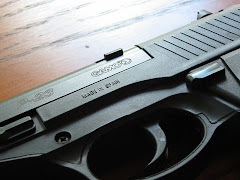
In part one we completed an overview of the Crosman 1377c, Gamo P-23 and Beeman P-17 Air pistols. We then examined the Crosman 1377c American Classic, and Gamo P-23 CO2 pistols in greater detail. Today, we'll take a more in depth look at the Beeman P-17.
P-17 History. As I mentioned in part one, the Beeman P-17 has a strange pedigree. Originally Weirech (Germany) designed and introduced the HW P 40 PCA with Beeman carrying a close copy marketed in the US as the Beeman P-3. Both were incredibly well engineered and well produced air pistols. Later things get fuzzy. At one point the US we saw three distinctly marketed products.
1. The Beeman P-3
2. The Marksman 2004
4. The Beeman P-17
(As I understand it both the Beeman and Marksman lines changed hands ending up held by S/R Industries (Sports and Recreation.)
I've yet to have anyone show me the specific differences between a P-3 and a Marksman 2004 (although I understand early 2004 quality control may have been off). Beeman states that the P-17 is the same pistol as the 2004 with a new name, so I'm not really qualified to illustrate any differences between them.
Why does any of this matter? Well for one thing the HW 40/ Beeman P-3 sold for a lot more money than the current Beeman P-17. If we can have the same performance for 60% less money that seems like a pretty strong value! (Don't worry for earlier owners though, I suspect their pistols will appreciate greatly in the collectors market).
Beeman P-17, single stroke pneumatic Air pistol, .177 Cal.
The P-17 is a single shot air pistol. Cocking the hammer allows the top half of the pistol to clam shell up and act as a lever for the single stroke pnuematic power plant. Pellets load directly into the breach inside of the top half which also contains the barrel. Closing the two halves completes the cocking stroke and resets the automatic safety.

I paid around $40.00 for my P-17 in a kit that came with a pair of shooting glasses and a tin of 250 Beeman Wadcutter Pellets.
The pistol itself resembles the Walther P-99 Series in the grip which is one thing I really enjoy about it. Although the P-17 is a large pistol, the excellent grip shape and medium weight make it easy to shoot well. It is also a very quiet pistol.
Recoil is almost non-existent, thanks the the pneumatic power plant and built in muzzle porting. Also, the trigger is pretty good right out of the box. Beeman rates the pistol at 410 fps (we'll check this soon), and describes the intended application as target shooting. And, I agree, for an
air pistol in this price range it's accuracy will amaze you.
P-17 Advantages.
1. Ergonomic grip fits wide variety of hands making the pistol easy to shoot well.
2. Has almost no recoil.
3. Outstanding accuracy.
4. Extremely quiet.
5. Low Cost.
P-17 Disadvantages.
1. Automatic safety takes getting used to.
2. Cocking effort is substantial and will be to great for some shooters.
3. Difficulty in loading pellets.

The last two disadvantages, particularly number three are what make me not shoot this
delightful airgun as much as I would like. The cocking effort is not that big an issue, but I have a terrible time getting pellets loaded because of difficulty in accessing the breach (see picture). Some times I think I actually end up getting the pellets flipped and loading them backwards.
In summary the outstanding accuracy of this German designed air pistol make it a must try for informal target shooting. Although the difficult pellet loading and strong cocking effort make reloading a chore.
For part three of this series we'll move on to performance testing. As we continue to evaluate the Crosman 1377c American Classic, the Gamo P-23, and the Beeman P-17 to find out which of these air pistols come out on top.
Until then...










